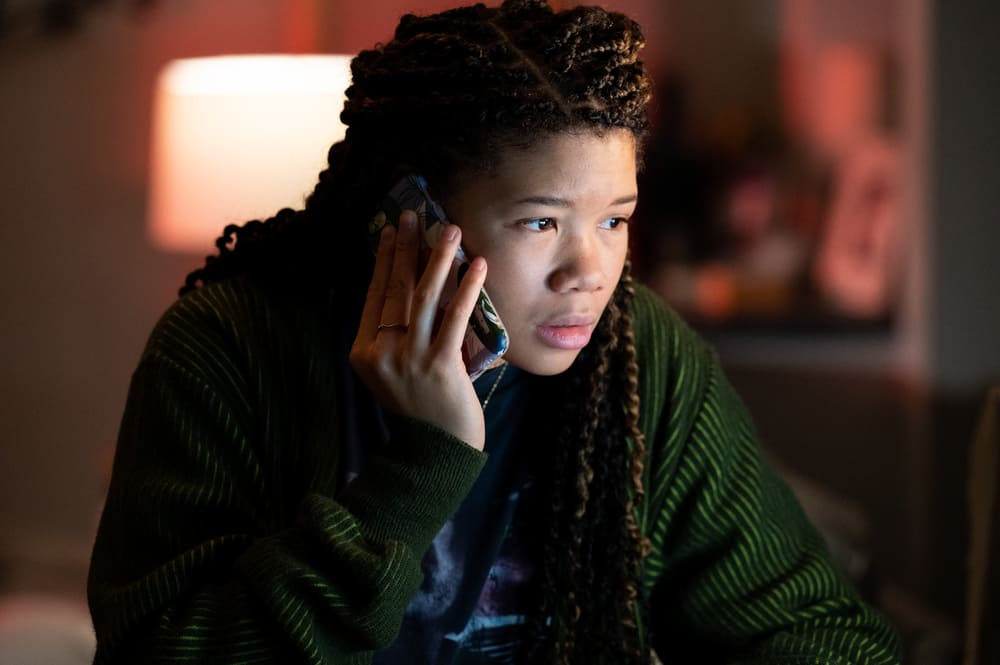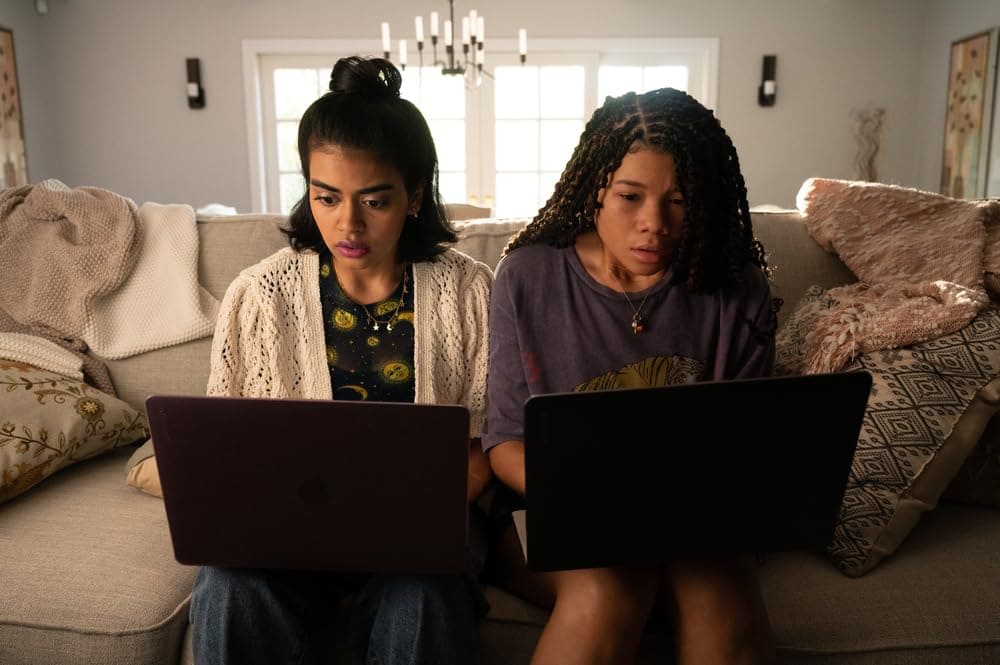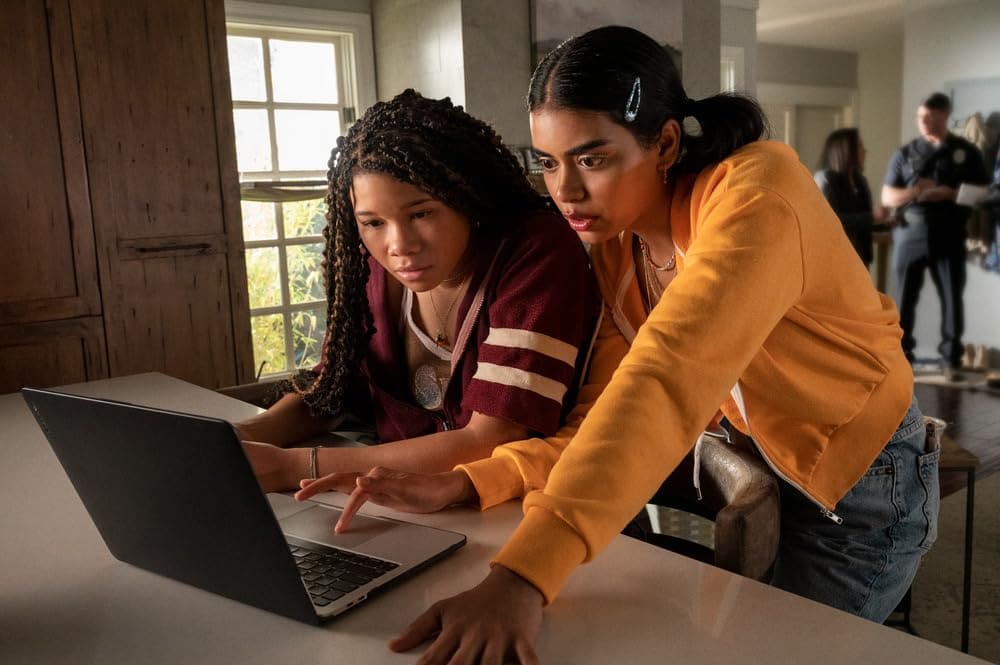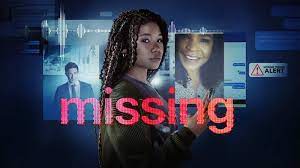Table of Contents
Plot
Welcome To Missing 2023 review. Missing (2023) is a screenlife thriller film that follows June Allen (Storm Reid), a teenager who tries to find her missing mother, Grace (Nia Long)
The film opens with a video montage of June and her father, James (Tim Griffin), who died from a brain tumor when she was young. June is now a talented hacker and computer whiz, and she uses her skills to navigate the digital world.
Grace and Kevin leave for Colombia on vacation, leaving June in the care of her mother’s friend, Heather (Amy Landecker), a divorce lawyer. A week later, June is supposed to pick up Grace and Kevin from the airport, but they never arrive. June contacts the FBI, but they are unable to do much because the disappearance happened in a foreign country.

June decides to investigate herself, using all the digital tools at her disposal. She hacks into Kevin’s Gmail account and discovers a number of aliases and a criminal record of scamming women out of their money. June also hires a Colombian gig worker named Javier (Daniel Henney) to help her with her investigation.
June’s investigation leads her to a number of disturbing revelations. She learns that Kevin has been using Grace to lure other women into his scams. She also learns that Grace is not who she seems. She has a secret past that June is not aware of.
June eventually tracks Kevin down to a remote cabin in the Colombian jungle. She confronts him, and he reveals that he has Grace captive. He explains that he kidnapped her because she knew too much about his criminal activities.
June manages to escape from the cabin and contact the FBI. The FBI arrives and arrests Kevin. However, Grace is nowhere to be found.
June is devastated. She blames herself for not being able to save her.
A few weeks later, June receives a mysterious message from an anonymous email address. The message contains a video of Grace, who is alive and well. Grace explains that she faked her own kidnapping in order to escape from Kevin. She also explains that she has been hiding out in a safe place.
June is overjoyed to see that her mother is safe. She and Grace are finally reunited.
However, the film ends with a shocking twist. June receives another message from the anonymous email address. The message contains a video of James Allen, who is alive and well. James reveals that he faked his own death in order to disappear from June’s life. He also explains that he kidnapped Grace in order to reunite with his daughter.
June is stunned. She doesn’t understand why her father would do such a thing. She is also angry at him for lying to her for so many years.
The film ends with June confronting James. She demands to know why he kidnapped her mother. James explains that he did it because he loves June and wanted to be a part of her life. He also explains that he was afraid that June would hate him if she knew the truth about his past.
June is still angry at James, but she also feels sorry for him. She realizes that he is a complex and troubled individual. She decides to give him a chance to prove that he can be a good father.
Action Sequences
The screenlife thriller film Missing (2023) features a few action sequences, although they are relatively brief and less intense than traditional action films. This is due to the film’s unique format, which follows the protagonist, June Allen (Storm Reid), as she uses her computer and phone to investigate her mother’s disappearance.
The first action sequence occurs when June confronts Kevin (Ken Leung) at his remote cabin in the Colombian jungle. Kevin has Grace (Nia Long) captive, and he threatens to kill her if June doesn’t leave. June refuses to back down, and she attacks Kevin. She punches him in the face and kicks him in the stomach. Kevin tries to fight back, but June is able to overpower him. She knocks him out and escapes from the cabin.

The second action sequence occurs when June is being chased by Kevin’s henchmen. She is running through the Colombian jungle, and she is trying to find a way to contact the FBI. The henchmen are close behind her, and they are firing their guns at her. June manages to evade them and find a safe place to hide.
The third and final action sequence occurs when June is confronted by her father, James Allen (Tim Griffin). James has kidnapped Grace, and he is trying to reunite with June. June is angry at James for lying to her and for kidnapping her mother. She attacks him, and they fight. James is bigger and stronger than June, but she is able to outsmart him. She uses her computer skills to hack into his phone and call the police. James is arrested, and June is finally safe.
The action sequences in Missing are well-choreographed and suspenseful. They are also relatively realistic, given the film’s screenlife format. The audience is able to experience the action through June’s eyes, which makes it feel more personal and immersive.
Here is a more detailed analysis of each action sequence:
June vs. Kevin
This action sequence is relatively short, but it is intense and well-choreographed. June is outnumbered and outmatched, but she is able to use her quick thinking and agility to defeat Kevin. The scene is shot from June’s perspective, which makes it feel more personal and immersive for the viewer.
June vs. Kevin’s Henchmen
This action sequence is more suspenseful than the first, as June is running for her life. The henchmen are close behind her, and they are firing their guns at her. June is able to evade them and find a safe place to hide, but it is clear that she is in danger.
June vs. James
This action sequence is the most emotional of the three. June is angry at James for lying to her and for kidnapping her mother. She attacks him, and they fight. James is bigger and stronger than June, but she is able to outsmart him. She uses her computer skills to hack into his phone and call the police. James is arrested, and June is finally safe.
Overall, the action sequences in Missing are well-executed and suspenseful. They help to keep the audience engaged and invested in the story.
Character Development
The character development in the movie “Missing” is complex and nuanced, with each character undergoing significant change over the course of the film.
June
At the beginning of the film, June is a typical teenage girl: she’s rebellious, self-absorbed, and struggling to find her place in the world. She’s also grieving the loss of her father, who died when she was young. When her mother goes missing, June is forced to step up and take charge of her own life. She uses her skills in technology and social media to investigate her mother’s disappearance, and in the process, she learns more about herself and her family than she ever knew before.

June’s character development is particularly evident in her relationship with her mother. At first, June is resentful of Grace for leaving her and her father. But as she learns more about Grace’s past and the reasons why she chose to leave, June begins to see her mother in a new light. She comes to realize that Grace was a strong and resilient woman who was willing to do whatever it took to protect her daughter.
By the end of the film, June has matured into a more confident and resourceful young woman. She has also developed a deeper appreciation for her mother and the sacrifices she made for her.
Grace
Grace is a complex and well-developed character. She is a loving mother who is fiercely protective of her daughter. But she is also a deeply flawed character who has made some bad choices in her life.
Grace’s character development is largely driven by her relationship with her ex-husband, James. James was a violent and abusive man, and Grace was forced to leave him and June in order to protect them both. She has spent the past 18 years building a new life for herself and her daughter, but James has never been far from her mind.
When James reappears in June’s life, Grace is forced to confront her past and make some difficult decisions. She realizes that she must protect June from James at all costs, even if it means putting herself in danger.
By the end of the film, Grace has come to terms with her past and is ready to move on with her life. She has also developed a deeper understanding of herself and her strengths.
James
James is a manipulative and dangerous character. He is determined to get revenge on Grace for leaving him, and he is willing to use anyone and anything to achieve his goals.
James’ character development is relatively limited, as he is largely motivated by his hatred for Grace. However, we do see some cracks in his facade towards the end of the film. For example, when he is confronted by June, he shows a hint of vulnerability and remorse.
It is possible that James could undergo further character development in a sequel, but for now, he remains a complex and villainous character.
Kevin
Kevin is a more sympathetic character than James. He is a troubled man who has made some bad choices in his life, but he is also capable of love and redemption.
Kevin’s character development is driven by his relationship with Grace. He is genuinely in love with her, and he is willing to do whatever it takes to protect her. However, he is also weak and easily manipulated by James.
By the end of the film, Kevin realizes that he has made a mistake by trusting James. He also realizes that he needs to change his life in order to be worthy of Grace’s love.
It is possible that Kevin could undergo further character development in a sequel, as he is a character with a lot of potential.
Overall, the character development in “Missing” is well-written and nuanced. Each character undergoes significant change over the course of the film, and their arcs are believable and relatable.
Themes
The movie “Missing” explores a number of complex themes, including:
Mother-daughter relationships: The film focuses on the relationship between June and Grace, and how their grief over the loss of James has strained their bond. June feels abandoned by her mother, who has been preoccupied with her new relationship with Kevin. Grace, meanwhile, feels guilty for not being there for June when she needed her most. As June investigates her mother’s disappearance, she begins to learn more about Grace’s past and the reasons for their estrangement.
Trauma and healing: June and Grace have both experienced significant trauma in their lives. June is still struggling to come to terms with her father’s death, while Grace has been carrying the burden of her own trauma for many years. The film explores the different ways that people cope with trauma, and the importance of finding healing.
The power of technology: The film uses technology in a unique way to tell the story. June uses social media, surveillance footage, and other online tools to track down her mother. The film shows how technology can be used for good, as June uses it to solve a crime and reunite with her mother. However, the film also warns about the dangers of technology, such as the potential for it to be used to manipulate and exploit people.
The importance of family: Despite their differences, June and Grace ultimately come together as a family in the face of adversity. The film shows the power of family love and support, even in the darkest of times.
In addition to these main themes, the film also explores other topics such as:
Grief and loss: The film deals with the complex emotions of grief and loss in a realistic and sensitive way. June and Grace both experience different stages of grief, and the film shows how grief can affect people in different ways.
Abusive relationships: The film also explores the dynamics of abusive relationships. James’s relationship with Grace is revealed to be an abusive one, and the film shows how Grace was able to find the strength to escape.
Exploitation: The film also sheds light on the issue of exploitation, particularly in the context of digital media. James uses social media to manipulate Grace and June, and the film shows how easily people can be exploited online.
The film “Missing” is a complex and thought-provoking thriller that explores a number of important themes.
Direction
The direction of the movie “Missing” (2023) by Will Merrick and Nick Johnson is notable for its use of screenlife, a filmmaking technique that utilizes only digital devices such as laptops, smartphones, and security cameras to tell a story. This technique was first used in the directors’ previous film, “Searching” (2018), and it is used to great effect in “Missing” to create a sense of immediacy and claustrophobia.
The film follows June Allen (Storm Reid), a teenager who tries to find her missing mother, Grace (Nia Long), after she disappears on vacation in Colombia with her new boyfriend, Kevin Lin (Daniel Henney). June’s investigation is conducted entirely through screenlife, as she uses her laptop, phone, and social media to track down clues and piece together what happened to her mother.

Merrick and Johnson use screenlife in a number of creative ways to tell the story. For example, they often use split-screens to show June using multiple devices at the same time, or to show different perspectives on the same event. They also use close-ups of June’s face and hands to create a sense of intimacy and immediacy.
The directors also use screenlife to create a sense of tension and suspense. For example, there are several scenes where June is talking to someone on the phone, but the other person is not shown on screen. This creates a sense of mystery and uncertainty, as the audience is not sure who June is talking to or what they are saying.
Overall, the direction of “Missing” is masterful. Merrick and Johnson use screenlife to create a unique and immersive cinematic experience. The film is suspenseful, thrilling, and emotionally resonant.
Here are some specific examples of how Merrick and Johnson use screenlife to their advantage:
In one scene, June is using her laptop to track Kevin’s location through his phone. The screen is split into two, with June’s laptop on the left and a map of Colombia on the right. As June scrolls through Kevin’s phone, the map updates in real time to show his location. This scene is both visually stunning and suspenseful, as the audience watches June get closer and closer to finding Kevin.
In another scene, June is talking to a Colombian police officer on the phone. The officer is not shown on screen, but June’s reaction to his words is clearly visible. This creates a sense of intimacy and immediacy, as the audience feels like they are right there with June as she tries to get information about her mother.
In the film’s climax, June is confronting Kevin in his hotel room. The scene is shot entirely from June’s perspective, using her laptop camera. This creates a sense of claustrophobia and suspense, as the audience feels like they are trapped in the room with June and Kevin.
Merrick and Johnson’s use of screenlife in “Missing” is a masterclass in filmmaking. They use this unique technique to create a visually stunning, suspenseful, and emotionally resonant film.
Cinematography
The cinematography of Missing (2023) is unique and innovative. The film is shot entirely on screens, using a variety of digital devices, including computers, phones, and tablets. This creates a sense of immersion for the viewer, as they are transported into June’s world.
The film’s cinematographer, Steven Holleran, uses a variety of techniques to create a visually interesting and engaging experience. He often uses close-ups and tracking shots to put the viewer in June’s shoes. He also uses data visualizations and augmented reality to create a sense of realism and suspense.
For example, in one scene, June is using her computer to track Kevin’s movements. Holleran uses a data visualization to show June’s progress. The data visualization is overlaid on the screen, and it gives June a clear picture of where Kevin is located.
In another scene, June is using augmented reality to search for her mother. Holleran uses augmented reality to create a ghostly image of Grace. The ghost image appears on the screen, and it helps June to track her mother’s movements.
Holleran’s cinematography is essential to the success of Missing. The film’s unique format would not be possible without his innovative techniques. He creates a visually interesting and engaging experience for the viewer, and he helps to tell the story in a compelling way.
Here is a more detailed analysis of some of the film’s most visually striking scenes:
June’s computer screen
June’s computer screen is often used to frame the action. This creates a sense of immersion for the viewer, as they are transported into June’s world. Holleran often uses close-ups of June’s computer screen to show her typing, clicking, and reading. This helps the viewer to follow along with her investigation.
Data visualizations
Holleran uses data visualizations to create a sense of realism and suspense. For example, in one scene, June is using her computer to track Kevin’s movements. Holleran uses a data visualization to show June’s progress. The data visualization is overlaid on the screen, and it gives June a clear picture of where Kevin is located.
Augmented reality
Holleran uses augmented reality to create a ghostly image of Grace. The ghost image appears on the screen, and it helps June to track her mother’s movements. This creates a sense of mystery and suspense, and it helps to keep the viewer engaged.
Overall, the cinematography of Missing is innovative and effective. Holleran uses a variety of techniques to create a visually interesting and engaging experience for the viewer. He helps to tell the story in a compelling way, and he makes the film’s unique format possible.
Music
The music of the movie “Missing” is a mix of original score and licensed tracks. The original score was composed by Julian Scherle, and it is a haunting and atmospheric piece of music that perfectly captures the tone of the film. The licensed tracks are a mix of contemporary and classic songs, and they are used to add emotional resonance to certain scenes.
One of the most notable uses of licensed music in the film is the song “Hella Cool” by Janaé E. This song is used in the opening scene of the film, and it sets the tone for the film perfectly. The song is upbeat and catchy, but it also has a dark undercurrent. This reflects June’s own personality, as she is a young woman who is trying to navigate the world on her own.
Another notable use of licensed music is the song “Alright Alright, Okay” by Black Caviar feat. G.L.A.M. This song is used in a scene where June is celebrating her birthday with her friends. The song is a celebration of youth and freedom, and it reflects June’s desire to break free from her past and start a new life for herself.
The original score by Julian Scherle is also very effective. The score is often used to create a sense of suspense and dread, and it helps to build tension in the film. The score also helps to underscore the emotional journey that June goes through over the course of the film.
Overall, the music of “Missing” is a vital part of the film. It helps to create the tone, atmosphere, and emotional resonance of the film. The licensed tracks and original score are both well-chosen and used effectively.
Here are some specific examples of how the music is used in the film:
In the opening scene, the song “Hella Cool” is used to establish June’s personality and her desire to break free from her past.
In a scene where June is investigating her mother’s disappearance, the score is used to create a sense of suspense and dread.
In a scene where June confronts her mother’s ex-husband, the score is used to underscore the emotional intensity of the scene.
In the final scene of the film, the score is used to create a sense of hope and closure.
The music of “Missing” is an important part of the film’s overall success. It helps to create a cinematic experience that is both suspenseful and emotionally resonant.
Personal opinion
I really enjoyed the movie “Missing.” I thought it was a well-made and suspenseful thriller that tackled some important themes.
I particularly appreciated the film’s exploration of the mother-daughter relationship. June and Grace’s relationship is complex and flawed, but it is also loving and resilient. I liked that the film showed how grief and trauma can strain relationships, but it also showed how family can be a source of strength and support.
I also thought the film did a good job of using technology to tell the story. June’s use of social media, surveillance footage, and other online tools to track down her mother was both clever and suspenseful. The film showed how technology can be used for both good and evil, and it made me think about the ways that technology is changing the way we interact with the world around us.
Overall, I thought “Missing” was a well-made and thought-provoking thriller. It was a suspenseful story with complex characters and important themes. I would definitely recommend it to fans of thrillers and anyone who is interested in exploring the mother-daughter relationship or the impact of technology on our lives.
Here are some specific things I liked about the film:
The acting was excellent, especially from Storm Reid and Nia Long.
The film did a good job of using technology to tell the story in a creative and engaging way.
The film explored some important themes in a thoughtful and nuanced way.
I would have liked to see the film explore some of the themes in more depth, but overall I thought it was a well-made and enjoyable thriller.
FAQs
Why is the movie “Missing” told entirely through screenlife?
The directors of “Missing,” Will Merrick and Nick Johnson, wanted to create a unique and immersive cinematic experience. They felt that screenlife was the best way to do this, as it allows the audience to feel like they are right there with the protagonist, June Allen, as she tries to find her missing mother.
What is the significance of the ending of the movie?
The ending of the movie reveals that June’s supposedly dead father, James, is behind the kidnapping of her mother in his attempt to reunite with his daughter. This twist is both shocking and heartbreaking, as it forces June to confront the truth about her family and her own identity.
